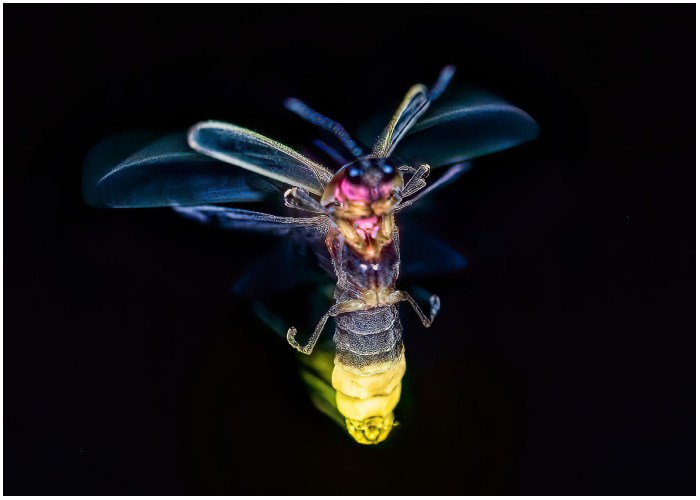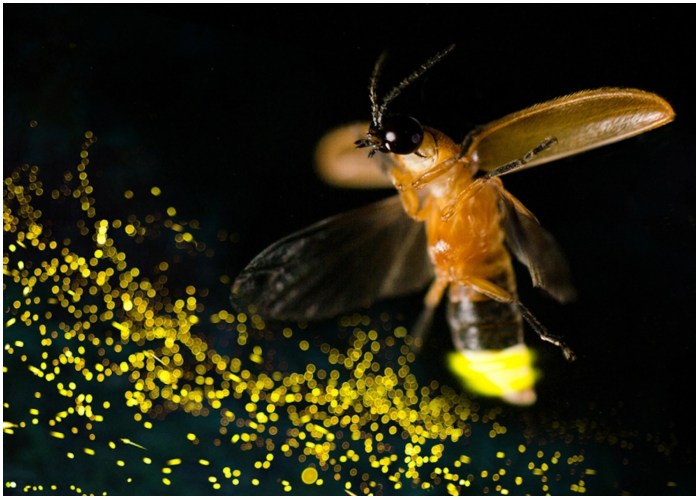It’s one of the quintessential signs of summer in parts of the United States: fireflies twinkling in the night. Fireflies’ ability to produce their own light is called bioluminescence, a phenomenon found in select animals, bacteria, and fungi all over the world. Most of these creatures live in caves or oceans, but a handful live where humans can see them, including the more than 2,000 species of beetles that make up the firefly family.
The Science Behind the Glow
The key to fireflies’ light is a chemical reaction based on a compound called luciferin. Luciferin makes light by losing electrons—a process called oxidation—in the presence of adenosine triphosphate (ATP), a molecule that provides energy for cells, and magnesium. This reaction is mediated by the enzyme luciferase. Fireflies have light organs in their abdomens where these reactions occur, containing a layer of crystallized uric acid that helps reflect and boost light. This system of using luciferin and luciferase has evolved independently several times in bioluminescent animals, including another group of light-up beetles.
The bioluminescence of fireflies is not just a simple glow; it is a complex interplay of chemistry and biology. The process begins when the firefly takes in oxygen, which reacts with luciferin inside the light-producing organ. The enzyme luciferase catalyzes this reaction, creating an excited state that emits light as it returns to the ground state. This emitted light can vary in color, from green to yellow to red, depending on the species of firefly and the environment.

Early Discoveries and Oxygen’s Role
Only in the last few hundred years have scientists started to understand how some living things can make light. One of the first significant discoveries was made in the 17th century when it was found that air was essential for a bioluminescent fungus to glow. Indeed, oxygen is one of the main ingredients for firefly bioluminescence. Fireflies need luciferin, luciferase, ATP, and magnesium to light up. Glowing starts early for fireflies, with pupae and even eggs able to make light, possibly as a signal to predators that they are not good to eat due to chemicals they synthesize from their diet. When fireflies reach adulthood, they make new light organs, with light coming from inside special cells on their undersides.
This early understanding of the role of oxygen was crucial in advancing the study of bioluminescence. It paved the way for further research into the biochemical pathways and genetic mechanisms that enable these organisms to produce light. Modern scientists have built on these foundational discoveries, using advanced techniques like genetic sequencing and molecular biology to unravel the mysteries of bioluminescence.
Mating and the On-Off Switch
These cells are full of luciferin and luciferase, as well as many mitochondria that pump out the ATP fireflies need to initiate the chemical reaction. Fireflies turn their light on and off through the flow of oxygen to these cells. No oxygen means darkness, while lots of oxygen means a glow. This on-and-off switch is important for fireflies on the U.S. East Coast that use flashing signals to find the right breeding partner. Each flashing species has evolved its own light sequence to distinguish itself from others, making bioluminescence a “Morse code love song in light.” With their extremely short adult lives, it’s a race against time to find a mate.
The mating rituals of fireflies are a fascinating example of how bioluminescence serves an essential ecological function. The males typically fly and emit specific light patterns, while the females respond with their own light signals from the ground. This light-based communication ensures that each species can find the right partner, thus maintaining the integrity of the species.
Unanswered Questions and Conservation Challenges
Researchers have come a long way in understanding the science behind firefly bioluminescence, but many firefly species remain undocumented in Asia and Africa. Scientists are still trying to understand how beetles first evolved their glow-in-the-dark specialty 130 million to 140 million years ago. A major breakthrough came in 1985 when researchers discovered the gene responsible for making luciferase. This enzyme is now used in biomedical research to artificially light up specific proteins in plants and animals. In 2024, researchers in China discovered two more genes in a rare aquatic firefly that may help position the lantern—the adult firefly’s glowing organ—in the abdomen and enable light-generating genes.

Besides deciphering firefly bioluminescence, scientists are still learning what makes fireflies tick in the wild. Recent years have seen firefly numbers dwindle due to light pollution, habitat loss, and climate change. Conservation efforts are hampered by the lack of understanding of fireflies’ natural habitats and basic requirements. How can fireflies be conserved and protected if their most basic needs are barely understood? The dwindling numbers of fireflies serve as a stark reminder of the delicate balance in our ecosystems. Efforts to conserve these magical insects must be based on a thorough understanding of their life cycles, habitats, and the specific threats they face. Collaborative research and conservation initiatives are crucial to ensure that future generations can continue to enjoy the enchanting glow of fireflies on warm summer nights.